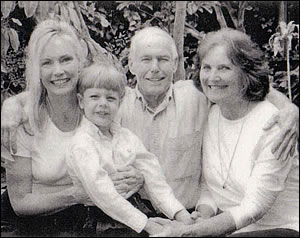 *In my safe driving lectures, when addressing the subject of aggressive driving and road rage, I dedicate this topic in memory of someone special, “Mr. Durham Sprague.”
*In my safe driving lectures, when addressing the subject of aggressive driving and road rage, I dedicate this topic in memory of someone special, “Mr. Durham Sprague.”Mr. Sprague was killed by someone driving aggressively on September 1, 2000; he’s seated in the center in the above picture, and his wife is seated on the right. He was a retired Carlsbad Firefighter who raised four children, three firefighter sons, a wonderful daughter, an excellent journalist, and one of my best friends – Jeannie! (She’s seated on the far left in the picture above with her son Sean.)
Mr. Sprague was killed on northbound 805 near Murray Ridge in San Diego as he attempted to merge into lanes. The aggressive-reckless driver was speeding and weaving through traffic when he struck Mr. Sprague’s vehicle, causing him to roll off the freeway. The driver who struck and killed Mr. Sprague had a history of reckless driving.
Sadly, aggressive driving kills and injures motorists every day on our roadways. Unfortunately, this type of driving often adds to the “road rage” factor. My safe driving lectures address “aggressive driving” with valuable tips on how to curb “road rage” – whether it’s your rage or that of another driver.
I talk about dealing with stress and road rage, either your anger or that of other drivers. My lectures will open your eyes to the dangers and how you can reduce these dangers on our roadways. The first thing to remember is – “We have NO control over other drives, but we do have control of our own actions.” In the 1990’s I was honored to assist with research on road rage with San Diego State University, NETS-Network of Employers for Traffic Safety, and the National Highway Traffic Safety Administration (NHTSA).
I provide my audience with a “professional and personal” look at what it takes to increase your survival on our roadways! Also, how to avoid making the same mistakes others have made that caused their collision. My goal is to make you more aware of the problems surrounding us and reduce the “risk factors” of having a collision.
These talks have been in high demand for Military Safety Stand-downs, Company Safety Briefings and Conferences, driver education/training courses, Colleges, parenting classes, and more. I do utilize some stats in my talks, but I put faces with those stats. Most are local faces. But, keep in mind – I don’t “sugar coat” the issues since my goal is to save lives! (Of course, when speaking to young teens and children, I am cautious about content.)
Tips for Dealing With Road Rage from the Department of Motor Vehicles (DMV):
Aggressive driving can cause many serious problems on the roadway. All drivers must be aware of both aggressive driving and the behavior known as “road rage,” and what to do when they occur.
There are two important things to be aware of regarding aggressive drivers:
- Recognizing and avoiding the behaviors in yourself.
- Avoiding other drivers engaging in these behaviors.
Ways to avoid becoming an aggressive driver include:
- Allow plenty of time to reach your destination.
- Do not “cut off” other drivers.
- Do not drive slowly in the left (fast) lane.
- Do not tailgate.
- Do not gesture to other drivers.
- Use your horn for emergencies only.
- Let aggressive drivers pass you.
The following are examples of common behaviors that can lead to aggressive driving and how to avoid them:
- Lane Blocking–Don’t block the passing lane. Stay out of the far left lane if other traffic wants to drive faster, and yield to the right for any vehicle that wants to pass.
- Tailgating–Maintain a safe distance from the vehicle in front of you. If you are being tailgated, leave more space between you and the vehicle in front of you.
- Signal Lights–Always use your signals when changing lanes, and avoid changing lanes too close to the other vehicles. After you have changed lanes, turn your signal off.
- Gestures–If you must gesture to another driver, do so in a way that will not be interpreted as hostile or obscene.
- Horn–Avoid using your horn to say “hello” to a pedestrian. The driver in front of you might think you are honking at them.
- Failure to Turn–Unless otherwise posted, right turns are allowed after a complete stop at a red light. Choosing to wait for the green light may frustrate the drivers behind you, but is not illegal.
- Parking–Do not take more than one parking space. Do not park in the disabled parking space if you do not have a disabled parking placard or plates.
- Headlights–If you use your high-beam headlights, dim your lights for oncoming traffic and when approaching a vehicle from behind; do not retaliate to oncoming high beams with your own.
- Merging–When traffic permits, make room to allow vehicles to merge into your lane.
If you would like me to speak to your group on this topic and other safe driving tips, please email your request to [email protected] – or call me direct at (619) 219-9030.
Stay Alert – Stay Alive!


